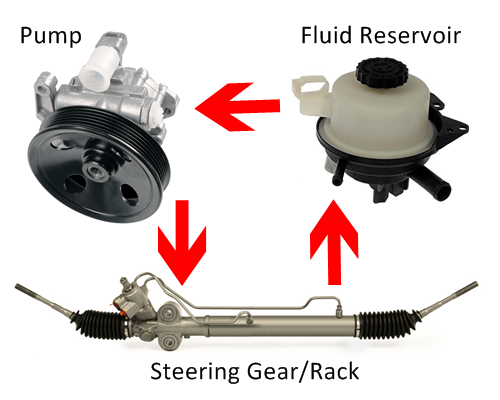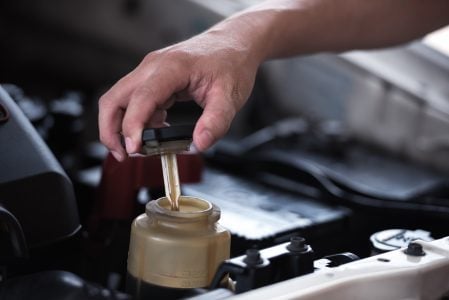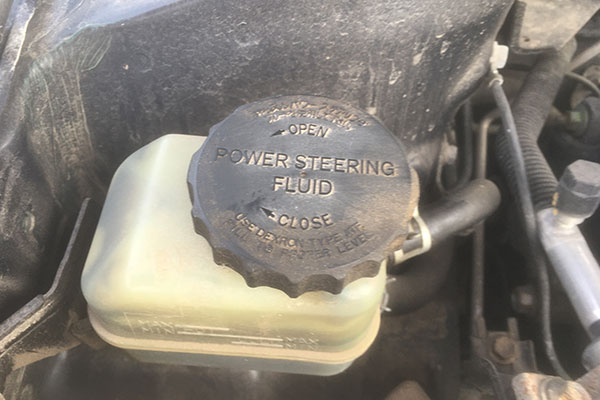Discover the wonders of automotive alchemy that reside right under your hood with power steering fluid—the unsung hero ensuring a smoother drive. Understanding it can seem like rocket science, but we’re about to slice through the jargon like a hot knife through butter. Ready to go from wary driver to road-scholar? Whether you’re rolling up your sleeves for DIY car maintenance or just seeking savvy owner insights, we’ve got your back. Navigate the nitty-gritty of power steering fluid—examining it, understanding its importance, and learning to refill it yourself. Buckle up; it’s time to go from zero to well-informed auto aficionado.
Table of Contents
What is Power Steering Fluid?

Power steering fluid is an integral part of your vehicle’s power-steering system, designed and developed to make your steering efforts smooth and hassle-free. This is because turning the steering wheel of a heavy vehicle can be quite a task if it isn’t assisted by power-steering. The power steering fluid is the magic potion that eases this job and ensures an effortless driving experience.
In essence, power steering fluid is a type of hydraulic fluid. Unlike most vehicle fluids, power steering fluid is not involved in combustion or cooling, and it doesn’t lubricate moving parts in the traditional sense. Instead, its main function is to transfer power from the engine to the steering system. It does this by flowing under high pressure through the steering gear, helping to reduce friction and wear on the steering components and making the steering wheel easier to turn.
It’s crucial to understand that power steering fluid operates in a closed system. It’s not burned off or consumed in any way while driving, meaning it needs to be replenished less frequently than other automotive fluids. Plus, a reservoir in your car holds the power steering fluid and pumps it into the steering gear as needed.
Over time, power steering fluid can break down due to heat and contamination, which can make steering components wear out faster. Therefore, it’s typically recommended it be changed at certain intervals or when signs of aging or contamination are apparent.
Powdered by the engine, the power steering pump pushes the fluid into the steering gear which applies the pressure that is required to turn the wheels. When the driver turns the steering wheel, the pressure is released in the direction of the turn, pushing the wheels round and assisting with the turn.
In terms of its physical characteristics, power steering fluid is thin enough to flow easily through hoses and small passages under high pressure, yet thick enough to damp vibrations and resist mechanical wear. It usually comes in a variety of colors ranging from clear, pink, or red to brown or black, depending on the brand and how long it’s been in the car.
On the whole, power steering fluid is a vital commodity in the automotive world, making your driving experience enjoyable every time you take the wheel. So, maintaining the right levels and ensuring its quality can save you from unanticipated glitches on the road.
Why is Power Steering Fluid Important?

While a racecar driver might yearn for the guttural feeling of raw, unassisted steering, most daily drivers appreciate the ease that power steering systems bring to their commutes. The secret sauce in this mechanical culinary delight? Power steering fluid.
Power steering fluid serves as the medium through which power is transferred from the steering wheel to the road wheels. It’s the unseen messenger silently whisking your directives from one component to another, ensuring a seamless and smooth driving experience.
Driving without power steering fluid would be akin to trying to send an email without an internet connection. It simply wouldn’t work. At least not without Herculean effort. And when it comes specifically to power steering, we generally want to minimize the need for Herculean effort.
Imagine turning a two-ton hunk of metal, plastic, and assorted vehicular ingredients without the aid of this marvelous fluid. You’d likely develop Popeye-like forearms in a week and probably end up following a semi-straight path rather than gracefully hugging the kiss of the curves on the road.
But power steering fluid isn’t only about convenience. It also plays an integral part in preserving your vehicle’s operational longevity. It helps to maintain the seals and O-rings in the system, ensuring that they remain in peak condition and function fully. Moreover, it also serves as a heat transfer agent, reducing temperature in the power steering pump, thereby preventing overheating and consequential damage.
In fact, it doesn’t stop there. This supreme fluid also acts as a rust and corrosion preventer for the metallic parts of the system, thus safeguarding these essential components from untimely degradation.
So, while invisible to the typical car owner, the humble power steering fluid serves as the unsuspecting superhero, ensuring not only an effortless driving experience, but also continually preserving and protecting your vehicle. Akin to the health of your vehicle, it should not be taken lightly.
How to Check Power Steering Fluid Level?

Checking the power steering fluid level in your vehicle isn’t something that requires a mechanic’s expertise. But get this: if you ignore the simple task, it can lead to uncomfortable steering wheel vibrations, not to mention excess strain on your precious power steering pump. So swallow that gearhead pride and let’s get under the hood, shall we?
First, the vehicle must be cool, as the fluid may be hot and the components you’re dealing with can be electrified or motorised. Park it, lock it and let it cool down. Remember, safety first – you wouldn’t try to pet a sleeping bear, so don’t fiddle with a hot engine.
Now, find the power steering fluid reservoir. It’s usually somewhere near the engine (a quick consultation with your vehicle’s manual should shine some light). Typically, it’s topped with a small cap that helpfully says something like “Power Steering Fluid.”
Remove the cap, often easily unscrewed. Don’t let anything foreign into the reservoir; any contamination with dirt or debris can affect the fluid’s performance. Seriously, this stuff is like a finely-tuned symphony for your vehicle’s steering system – one wrong note, and you’ve got the orchestral equivalent of a flat tire.
Most reservoirs will have a dipstick built into the cap, or indicators on the tank itself that let you know the fluid level when the engine is cool or hot. Like a master chef testing a souffle, dip the stick in, remove it, wipe it clean and dip it in again for an accurate reading. The fluid should ideally be within the ‘Min’ and ‘Max’ markers on the dipstick.
If the level is below minimum, then oh boy, is it your lucky day! You spotted a potential crisis before it became one. If it’s above maximum, however, you must consult a professional – overfilling can lead to power steering damage. That’ll be a bitter pill to swallow for a gearhead.
While you’re at it, check the color of the fluid. If it’s brown or black, it’s time to replace it. Top quality power steering fluid is usually a clear, light amber color, like a really well-aged whiskey – though I wouldn’t recommend tasting it, no matter how good it looks!
So there you have it. A smooth steering wheel, brought to you by taking few minutes every once in a while to peek under your car’s hood. The more you know, the longer your car will thank you. Don’t ignore the chance to play mechanic – you’ll be saving yourself a whole heap of trouble down the line.
How to Fill Power Steering Fluid?
:max_bytes(150000):strip_icc()/2375313537_e0c0b6b4c1_o-56a056435f9b58eba4afef9c.jpg)
Filling your power steering fluid ain’t rocket science, folks – but it still requires some care and precision. First things first, make sure your engine is cold. You don’t want a nasty burn; that fluid can get hot after a drive.
So, locate the power steering reservoir in your bonnet. This varies depending on your vehicle, but it’s usually marked with a steering wheel icon or specifically labelled for your convenience. Once you’re there, remove the reservoir cap and wipe the dipstick clean to avoid contamination from rogue debris.
Now, this next part is when precision comes into play. Using a funnel, pour in your preferred power steering fluid slowly, making sure not to overfill. What’s the right fluid, you ask? Check your vehicle’s manual. The type of power steering fluid varies from vehicle to vehicle. So, pour that liquid gold and fill up to the ‘MAX’ line. If you don’t see lines indicating ‘MIN’ and ‘MAX’, that probably means you need to turn to the car’s manual again.
Should you accidentally overfill, don’t panic. It’s not the end of the world. Sneak in there with a turkey baster or some kind of suction device to remove the excess and save your engine from any potential damage.
Having filled the reservoir, replace the cap firmly to avoid spillage or aeration. Start the engine and turn your steering wheel from left to right a few times. This is to ensure the fluid has circulated thoroughly through the system. Then, turn off your engine and recheck your fluid level.
In case you’ve drained it too low during operation, top it off until you hit the ideal mark. But if your fluid levels are dropping frequently or drastically, you might want to check in with a professional. Last thing you need is a leaky system gnawing at your wallet… and your safety.
Go forth now, armed with newfound knowledge. You’re not just handy – you’re a deft commander in the art of power steering fluid. Remember, maintaining your vehicle isn’t just mechanical; it’s love, respect and the key to smooth, safe journeys.
Next time you hit a tricky parallel park, know that it’s not just your stellar driving skills – it’s also that high-level power steering fluid doing its job. So, hats off to you, the unsung mechanic. Now pat yourself on the back – you’ve earned it!
Frequently Asked Questions about Power Steering Fluid

What most practitioners of automotive upkeep desire is a more in-depth understanding of power steering fluid. As one may expect, a melange of inquiries crop up often. And to you, dear reader, looking for knowledge and calm in such turbulent seas – you’ve come to the right place.
“Can I drive with low power steering fluid?” is a question that surfaces with unnerving frequency. While you could technically still navigate your vehicle with a paucity of fluid, it isn’t recommended. A deficiency in power steering fluid can lead to increased wear and tear on your system, an unwelcome guest in any car owner’s life. Indeed, with a severe shortage, you may find your steering unresponsive. Better safe and seamlessly maneuvering than sorry and sidetracked by a sidelined system.
Next up is, “Does power steering fluid need to be changed?” Power steering fluid isn’t immune to the ravages of time, and while it may not need as frequent changes as your oil, it still demands attention. Usually, the recommendation is every 30,000 to 60,000 miles, but consult your vehicle’s manual to be sure.
Now, “What color should my power steering fluid be?” Barring any catastrophic errors, you’re looking for a color akin to fresh, pure honey. Conversely, if your fluid is excessively dark, it might be time for a replacement. Reddish hues, on the other hand, may indicate a blend with transmission fluid, which is an issue to tackle without delay.
Then there’s, “Can I use any fluid for my power steering?” In theory, any hydraulic fluid might do the trick, but in practice, sticking to the manufacturer’s recommended type is going to prevent unnecessary tribulations. Subbing in the wrong fluid can lead to a compromised system and unexpected costs.
Lastly, “What are the signs of low or bad power steering fluid?” Noise is a giveaway. If your car groans every time you turn, it’s crying for a top-up. Difficulty in steering, or a ‘hard’ feeling when turning is another sign. Also, the fluid level itself can indicate a leak if it keeps decreasing rapidly.
All in all, power steering fluid might seem like a footnote in the tome of car maintenance, but it’s a paragraph certainly worth noting and revisiting from time to time.
Conclusion
Maintaining your power steering fluid isn’t just a walk-in-the-park chore — it’s a crucial responsibility that’s integral for the longevity of your car. With this guide, you’ve got the know-how to check and fill your power steering fluid properly, ensuring a smoother, safer drive. Now, you can sidestep unnecessary mechanic’s bills, and take the wheel on the health of your vehicle. Don’t underestimate these fluids, they’re the lifeblood of your car. So, pull on those work gloves and let’s keep the wheels turning smoothly!
